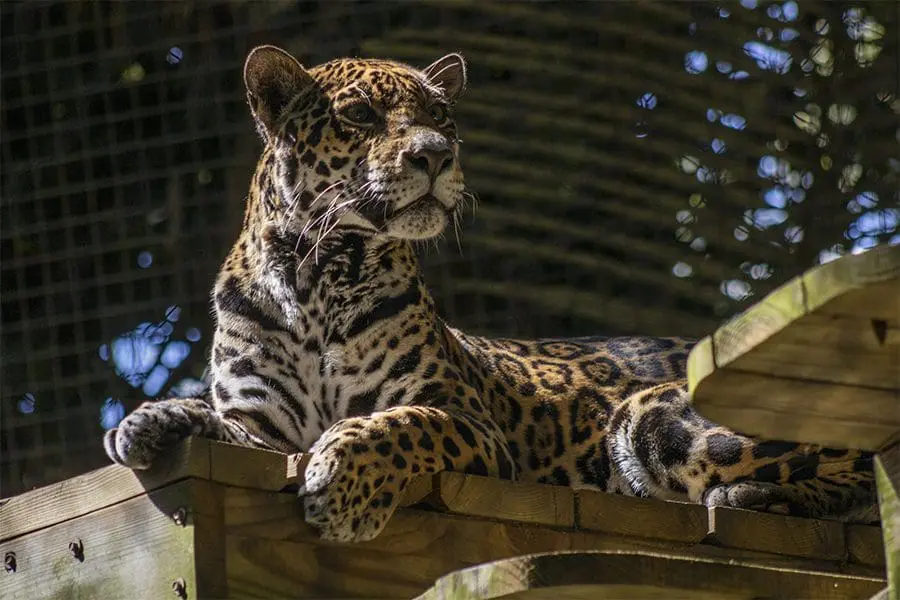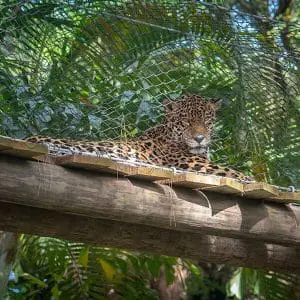

Happy International Jaguar Day, Masaya!
It’s International Jaguar Day – and there’s no better way to celebrate than by learning more about our female jaguar Masaya! You can spot Masaya in our Rainforest Revealed loop.
Despite her advanced age – Masaya will turn 19 years old on Christmas Eve (December 24) – she’s shown no age-related issues so far.
“Her age is not slowing her down one bit,” said Rainforest Revealed Area Supervisor Sidnee Santana-Mellor.
Masaya again has access to two of the three habitats slated for jaguars at our Zoo! Our bobcat Eko had lived in one of them for a time while his habitat in our Wild Florida area was renovated (he recently moved back!), and our cheetah Pepper is using the remaining habitat as a “retirement home.”
Jaguars are solitary by nature, so Masaya hasn’t shown any negative effects after the passing of our male jaguar Mulac at the start of this year. She’s become less possessive over enrichment now that she has a territory to herself, Sidnee said.
For one of Masaya’s preferred enrichments, her keepers scent mark different spots throughout her habitat with a rabbit smell before hiding the rabbit in a difficult place for Masaya to find and “hunt” the rabbit.
“This enrichment simulates how she would find prey in the wild,” Sidnee said.
 She spends her morning searching for her meal in various enrichment or doing a training session with keepers. The rest of the day is spent moving her larger enrichment items around, taking a dip in her pool, watching guests from our tunnel system or finding an ideal nap spot.
She spends her morning searching for her meal in various enrichment or doing a training session with keepers. The rest of the day is spent moving her larger enrichment items around, taking a dip in her pool, watching guests from our tunnel system or finding an ideal nap spot.
Masaya has learned a number of behaviors that help with her care. One of her keepers is working on injection training Masaya so she can get any injections she may need voluntarily.
Masaya has been with our Zoo since 2005. She has had six cubs in her life through breeding recommendations by the Species Survival Plan (SSP) for jaguars. SSPs ensure that there are genetically diverse, healthy populations of animals in facilities accredited by the Association of Zoos and Aquariums. A few of Masaya’s offspring have gone on to have cubs of their own – Masaya is technically a grandma to 11 jaguars!
“She is an amazing ambassador for her species,” Sidnee said.
Jaguars in their natural range are at a near threatened endangered status, with populations declining due to habitat loss and human hunting for their pelts. Ranchers also kill jaguars due to the big cats preying on their livestock.
In the past, our Zoo – and you – have supported organizations like the Northern Jaguar Project through our Quarters for Conservation program, which supports featured conservation organizations through the donation of twenty-five cents of each daily ticket and $5 from each membership purchased at our Zoo. The Northern Jaguar Project extends protection for jaguars in the buffer zone surrounding the 55,000-acre Northern Jaguar Reserve in Sonora, Mexico. This reserve has proved successful at protecting a small population of big cats, although jaguars in this region are still critically endangered.
Brevard Zoo is an independent, not-for-profit organization that receives no recurring government funding for our operating costs. Your generous support enables us to continue to serve our community and continue our vital animal wellness, education and conservation programs.
